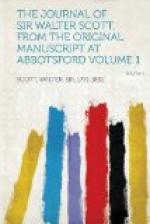“I did not think on Craignethan in writing about Tillietudlem, and I believe it differs in several respects from my Chateau en Espagne. It is not on the Clyde in particular, and, if I recollect, the view is limited and wooded. But that can be no objection to adopting it as that which public taste has adopted as coming nearest to the ideal of the place. Of the places in the Black Dwarf, Meiklestane Moor, Ellislie, Earnscliffe, are all and each vox et, praeterea nihil. Westburnflat once was a real spot, now there is no subject for the pencil. The vestiges of a tower at the junction of two wild brooks with a rude hillside, are all that are subjects for the pencil, and they are very poor ones. Earnscliffe and Ganderscleuch are also visions.
“I hope your work is afloat[B] and sailing bobbishly. I have not heard of or seen it.
“Rob Roy has some good and real subjects, as the pass at Loch Ard, the beautiful fall at Ledeard, near the head of the lake. Let me know all you desire to be informed without fear of bothering. Kindest compliments to Mrs. Skene and the young folks.—Always yours entirely, WALTER SCOTT.”
[B] Twenty numbers of this work were published in 1828 and 1829 under the title of “A Series of Sketches of the existing Localities alluded to in the Waverley Novels,” etched from original drawings by James Skene, Esq.
[347] A copy of this rather rare book is still in the Abbotsford Library. Its title is “Colonel Wm. Francklin’s Military Memoirs of George Thomas, who by extraordinary talents and enterprise rose from an obscure situation to the rank of General in the service of the Native Powers in the N.W. of India,” 4to, Calcutta, 1803.
[348] The poem of this name is attributed to King James I. of Scotland, but Dr. Irving in his History of Scottish Poetry says the earliest edition known to him dates only from 1663.
[349] Professor of Logic in the University of Edinburgh from 1775 till 1792, when he resigned his chair and became Keeper of the State Paper Office, and Historiographer to the East India Company in London. He wrote several elaborate and valuable reports for the Government, which, though printed, were never published; among others, one in 1799, in 2 vols. 8vo, “On the Union between England and Scotland: its causes, effects, and influence of Great Britain in Europe.” In the previous year he also prepared another on the arrangements made for repelling the Armada, and their application to the crisis of 1798. This able man returned to Scotland, and died in Falkland about two years before Scott visited the place.
[350] An account of the finding of this seal (which was thought to be that of Joan of Beaufort, wife of James I.) at Kinross, in April 1829, is given in the Archaeologia Scotica, vol. iv. p. 420.




